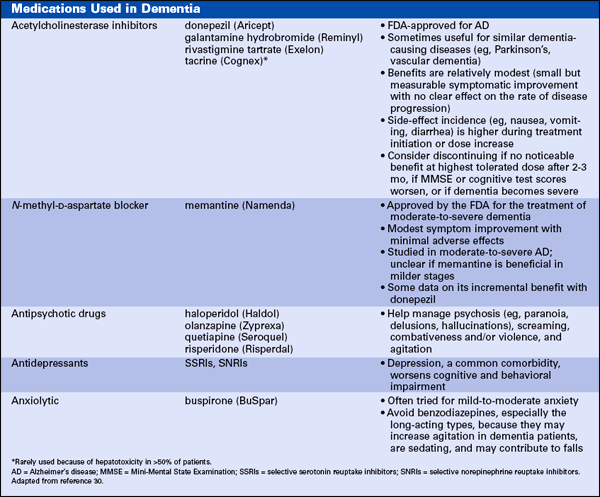Publication
Article
Pharmacy Times
2-minute Consultation: Dementia: Many Facets, No Cure
Author(s):
Dementia is a growing concern for the aging population.
Ms. Wick is a senior clinical researchpharmacist at the National CancerInstitute, National Institutes of Health,Bethesda, Maryland. The viewsexpressed are those of the author andnot those of any government agency.

Mention dementia these days,and you are as likely to heara memory joke as you are tosee a fleeting look of fear. Four dementiasare common: Alzheimer's disease(AD; now affecting approximately 4.5million Americans1-5), vascular dementia(VaD), dementia with Lewy bodies(DLB), and frontotemporal dementia(FD).6 Irreversible and incurable, dementiacan be almost impossible to categorizeuntil autopsy; yet, earlier diagnosisis associated with better prognosis.7-9
Some memory loss is normal. Age-associatedCognitive Impairment (AACI)(or, benign memory impairment) occursin up to 39% of elders10; experiencesinclude tip-of-the-tongue events(word-finding failures), slower learningor concentration, and mild forgetfulness.11 AACI patients navigate dailyactivities satisfactorily, at times jokingabout their deficits.6,12,13
Alzheimer's Dementia
AD progresses slowly. Patients oftenare aware of faltering short-term memoryand hide it until later stages of AD.AD patients do not learn, and promptingis useless. Eventually, disorganizedthinking and often psychotic mood andpersonality disorders incapacitate patients.1 Most AD patients live <8 yearsafter diagnosis; comorbidities shortensurvival.14
Vascular Dementia
Once called multi-infarct dementia,VaD's risk factors include hypertension,diabetes, arterial disease, andsmoking.15-17 VaD patients are acutelyaware of their deficits and learn, butthey may recall material only afterhints. VaD impairment plateaus untilanother cerebral accident. Gait disorders,depression, apathy, and moodand behavioral changes are common.15,18-20 To prevent VaD, cliniciansuse antiplatelet therapy, control hypertension,and address risk factors.20
Frontotemporal Dementia
FD (or, Pick's disease) causes behavioralchanges and language problemsin adults aged 35 to 75.21,22 Disinhibitedand socially inappropriate, FD patientsoften lack empathy and develop poorhygiene.21 Compulsive behaviors canbe self-destructive (eg, exiting a movingvehicle) or criminal (eg, theft), readingand writing skills erode, and somepatients become mute in as little as 2years.23 FD is untreatable; therefore,management targets agitation andbehavior.21
Dementia with Lewy Bodies
Fifteen percent to 25% of dementiapatients have DLB24; severe dopaminergicloss causes bradykinesia, difficultyexecuting fine motor skills, maskedface, stooped posture, and shufflingthat looks like Parkinson's disease (PD)but less severe.25 Because DLB's symptomsfluctuate widely hourly and daily,others may suspect that DLB patientsare "faking it."
Vivid (but not frightening) visual hallucinationsoften occur during seriousconfusion.26 Capgras syndrome—believinga significant other is an imposter—is common, as well as apathy,depression, slowed thought processes,getting lost easily, insomnia, autonomicdysfunction, and losing one'sthought midsentence.25 In almost halfof DLB patients, neuroleptic exposureworsens the PD-like symptoms, increasescognitive deficits and hallucinations,and can cause life-threateningneuroleptic malignant syndrome.26-28
Conclusion
Between 20% and 50% of dementiapatients have mixed dementias.16,29Clinicians treat mixed-dementia patientsempirically. Currently, severaldrugs are available to treat dementia;none are curative or more than satisfactoryin their effects. Most patientswith dementia end life in an institution.Perhaps this will not always be thecase.
Table

References
- Honig L. Recognition of vascular dementia, dementia with Lewy bodies, and frontotemporal dementia. ci.columbia.edu/c1182/web/sect_5/c1182_s5_2.html. Accessed November 6, 2007.
- Hebert LE, Scherr PA, Bienias,JL, Bennett DA, Evans DA. Alzheimer disease in the US population: prevalence estimates using the 2000 census. Arch Neurol. 2003;60:1119-1122.
- Evans DA, Funkenstein HH, Albert MS, et al. Prevalence of Alzheimer's disease in a community population of older persons. Higher than previously reported. JAMA. 1989;262:2551-2256.
- Larson EB, Shadlen MF, Wang L, et al. Survival after initial diagnosis of Alzheimer disease. Ann Intern Med. 2004;140:501-509.
- Alzheimer's Association. Statistics about Alzheimer's Disease. www.alz.org/AboutAD/statistics.asp. Accessed November 6, 2007.
- Pokorski RJ. Differentiating age-related memory loss from early dementia. J Insur Med. 2002;34:100-113.
- Folstein MF, Folstein SE, McHugh PR. "Mini-mental state". A practical method for grading the cognitive state of patients for the clinician. J Psychiatr Res. 1975;12:189-198.
- Finkel S. Screening for dementia in primary care practice. A Medscape CE. www.medscape.com/viewarticle/423409_3. Accessed November 6, 2007.
- Solomon PR, Pendlebury WW. Recognition of Alzheimer's disease: the 7 Minute Screen. Fam Med. 1998;30:265-271.
- Mintzer J, Burns A. Anticholinergic side-effects of drugs in elderly people. J R Soc Med. 2000;93:457-462.
- Shafto MA, Burke DM, Stamatakis EA, Tam PP, Tyler LK. On the Tip-of-the-Tongue: Neural Correlates of Increased Word-finding Failures in Normal Aging. J Cogn Neurosci. 2007; [Epub ahead of print].
- Milisen K, Braes T, Fick DM, Foreman MD. Cognitive assessment and differentiating the 3 Ds (dementia, depression, delirium). Nurs Clin North Am. 2006;41:1-22.
- Gauthier S, Reisberg B, Zaudig M, et al. Mild cognitive impairment. Lancet. 2006;367:1262-1270.
- Larson EB, Shadlen MF, Wang L, et al. Survival after initial diagnosis of Alzheimer disease. Ann Intern Med. 2004;140:501-509.
- Alagiakrishnan K, Masaki M. Vascular dementia. www.emedicine.com/med/topic3150.htm. Accessed November 6, 2007.
- Langa KM, Foster NL, Larson EB. Mixed dementia: emerging concepts and therapeutic implications. JAMA. 2004;292:2901-2908.
- Nagata K, Maruya H, Yuya H, et al. Can PET data differentiate Alzheimer's disease from vascular dementia? Ann N Y Acad Sci. 2000;903:252-261.
- Graham NL, Emery T, Hodges JR. Distinctive cognitive profiles in Alzheimer's disease and subcortical vascular dementia. J Neurol Neurosurg Psychiatry. 2004;75:61-71.
- Allan LM, Ballard CG, Burn DJ, Kenny RA. Prevalence and severity of gait disorders in Alzheimer's and non-Alzheimer's dementias. J Am Geriatr Soc. 2005;53:1681-1687.
- Chow T. A dementia by any other name: what if it is not Alzheimer's disease? Alzheimer's Care Quarterly. 2005;6:215-224.
- National Institute of Neurological Disorders and Stroke. NINDS frontotemporal dementia information page. www.ninds.nih.gov/disorders/picks/picks.htm. Accessed November 6, 2007.
- Snowden JS, Neary D. Neuropsychiatric aspects of frontotemporal dementias. Curr Psychiatry Rep. 1999;1:93-98.
- University of California, San Francisco Memory and Aging Center. Frontotemporal dementia (FTD). memory.ucsf.edu/Education/Disease/ftd.html. Accessed November 6, 2007.
- McKeith IG, Galasko D, Kosaka K, et al. Consensus guidelines for the clinical and pathologic diagnosis of dementia with Lewy bodies (DLB): report of the consortium on DLB international workshop. Neurology. 1996;47:1113-1124.
- Bradley BF. Dementia with Lewy Bodies. In: Dementia. Continuum: Lifelong Learning in Neurology. 2004;10:81-112.
- Lewy Body Dementia Organization. LBD symptoms. www.lewybodydementia.org/symptoms.php. Accessed November 6, 2007.
- Santacruz KS, Swagerty D. Early diagnosis of dementia. Am Fam Physician. 2001;63:703-713, 717-718.
- Walker Z, Costa DC, Walker RW, et al. Differentiation of dementia with Lewy bodies from Alzheimer's disease using a dopaminergic presynaptic ligand. J Neurol Neurosurg Psychiatry. 2002;73:134-140.
- Rockwood K, Macknight C, Wentzel C, et al. The diagnosis of "mixed" dementia in the Consortium for the Investigation of Vascular Impairment of Cognition (CIVIC). Ann N Y Acad Sci. 2000;903:522-528.
- Lleó A, Greenberg SM, Growdon JH. Current pharmacotherapy for Alzheimer's disease. Annu Rev Med. 2006;57:513-533.







